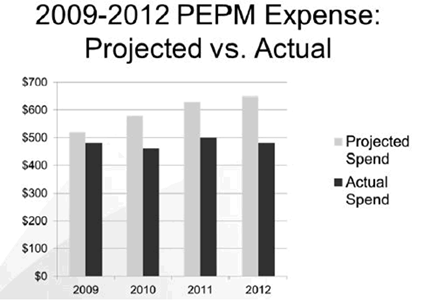Today, compensation consultant Carla McCormick offers a case study that shows the value of Value-Based Benefits Design (VBBD).
McCormick, who is with Fallon Benefits Group, made her remarks at BLR’s Advanced Employment Issues Symposium, held recently in Las Vegas. (BLR is CER’s parent company.)
Case Study in VBBD
Some facts about the client:
- Global presence with more than 7,000 covered lives
- Employee population includes office staff, manufacturing, and drivers
- Average employee age: 45 years
- Very low turnover
The client established the following healthcare program objectives:
- Control escalating healthcare costs without shifting costs to employees.
- Manage the impact of chronic illness proactively.
- Reduce the cost trend to a level below the market average.
- Improve or maintain the health of all plan participants.
- Foster a culture of health.
- Implement a world-class wellness program.
The program was put into place over a number of years, as follows:
|
2005 |
|
|
2006 |
|
|
2007 |
|
|
2008 |
|
|
2009 |
|
|
2010 |
|
|
2011 |
|
Total rewards statements: Webinar coming next week! Learn more.
The Results
The chart speaks for itself—Per Employee Per Month (PEPM) costs are contained.

McCormick offered several more tips for those considering VBBD:
- Keep it simple. If the program is too complicated, people won’t participate.
- Honor the health culture. Don’t, as one client did, celebrate the end of a dieting program with cake and ice cream.
- Work with your carrier. Many insurance carriers offer or can be talked into offering wellness programs at no cost.
- Know your numbers. Be sure that employees understand what “their numbers” (for example, cholesterol, blood pressure, body mass index) mean.
- Don’t overestimate ROI. If you do, management will pull the plug before you have a chance to show results.
Benefits design—important, to be sure, but not the only challenge on your plate. Another challenge is making employees see the real value of everything you’re providing them, in a way they can easily understand.
Total Rewards Statements: Harness Your Employee Value Proposition to Boost Retention and Engagement
Live webinar coming Wednesday, February 19, 2014
10:30 a.m. to Noon Pacific
A recent survey revealed that the "employee value proposition" (EVP)—the balance between rewards and benefits offered to the workforce in exchange for performance—remains an untapped mine for many organizations, yet workplaces with effective EVPs tend to stand out from the crowd.
Of those organizations that were surveyed, the ones that were identified as having highly effective EVPs combined extrinsic factors such as pay, bonuses, and benefits with intrinsic ones such as teamwork and work environment. Many of those organizations also used their strategy to steer employees’ behavior toward helping foster company strategy and financial success.
Helping employees understand the value of the total rewards they are getting in exchange for their service is a critical component of a successful organization’s EVP strategy. When employees know the score, they will be more inclined to produce at a higher level and to stick around for the long haul as engaged members of your team—and that’s where total rewards statements come into play.
Join us on February 19 for an in-depth webinar on how to construct total rewards statements that accurately convey the true value employees get through their salary and benefits and learn how that can have a positive effect on employee engagement and productivity.
You’ll learn:
- The business case for investing in total compensation statements, and where they fit into an organization’s strategy in addressing the "employee value proposition"
- Stakeholders who benefit from total rewards statements and how
- Key data to gather in anticipation of drafting your total rewards statements, and design tips to ensure that you’re communicating clearly and effectively with your employees
- Essential items to include in total rewards statements and why
- How to accurately calculate the true value of your rewards so employees understand how those perks can be monetized as part of their total compensation package
- How to use total rewards statements to illustrate the link between salary and benefits and the organization’s strategic goals
- Best practices for rolling out your total rewards statements
- Pitfalls to avoid when creating your total compensation statements
- And much more!
In just 90 minutes, you’ll learn how to communicate the investments your organization makes in the workforce in a manner that clearly illustrates just how competitive your compensation package is. Register now for this informative event risk-free.
Download your copy of Employee Orientation: How To Energize, Integrate, and Retain Your Newest Hires today!

Would VBBD be effective for smaller employers, too?